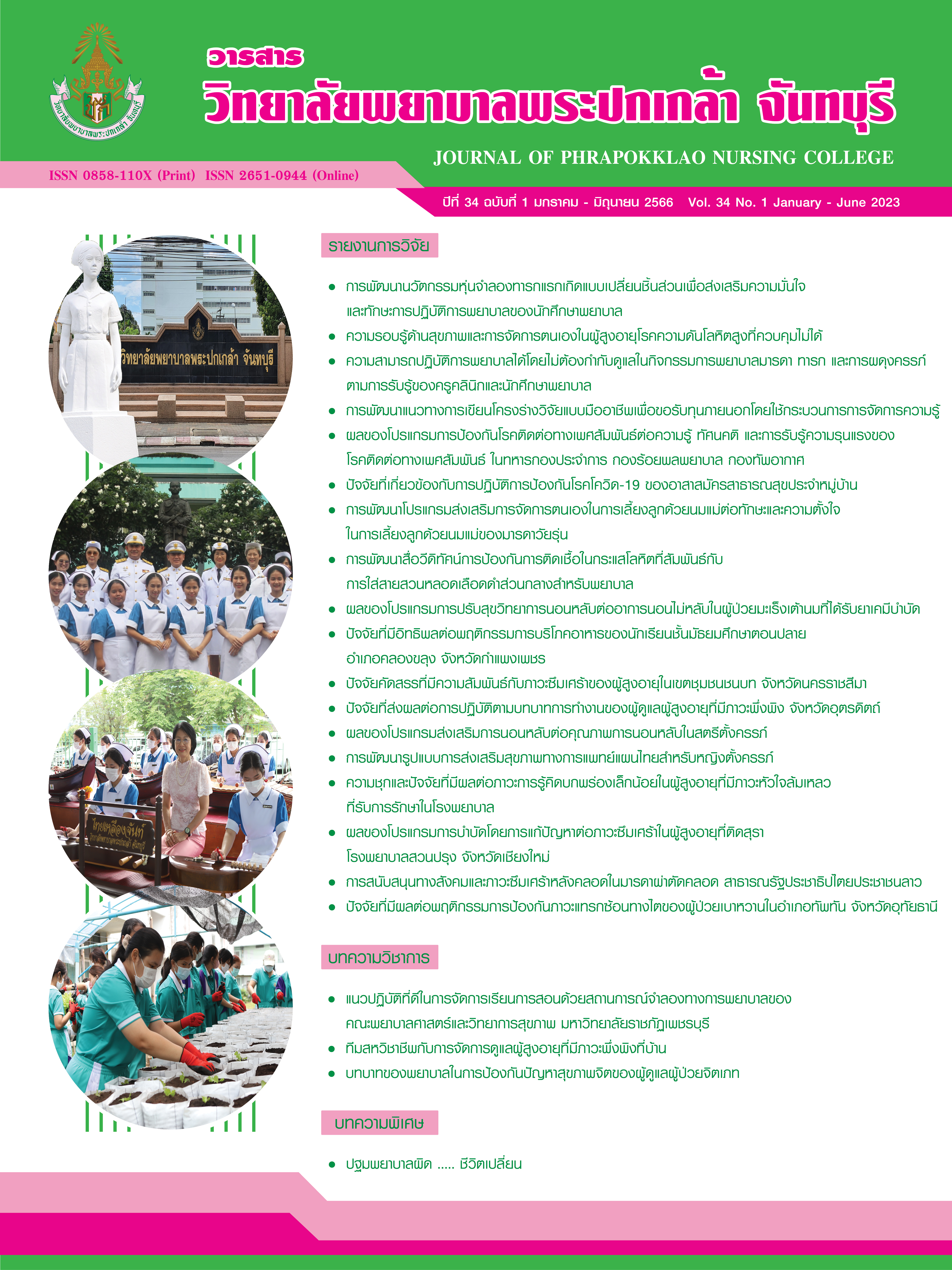การพัฒนาสื่อวีดิทัศน์การป้องกันการติดเชื้อในกระแสโลหิตที่สัมพันธ์กับการใส่สายสวนหลอดเลือดดำส่วนกลางสำหรับพยาบาล
คำสำคัญ:
สื่อวีดิทัศน์, การติดเชื้อในกระแสโลหิต, การป้องกัน, การใส่สายสวนหลอดเลือดดำส่วนกลางบทคัดย่อ
การวิจัยครั้งนี้เป็นการวิจัยเชิงพัฒนา เพื่อพัฒนาและประเมินประสิทธิภาพของสื่อวีดิทัศน์การป้องกันการติดเชื้อในกระแสโลหิตที่สัมพันธ์กับการใส่สายสวนหลอดเลือดดำส่วนกลางสำหรับพยาบาล กลุ่มตัวอย่างเป็นพยาบาลแผนกอายุรกรรม โรงพยาบาลมหาวิทยาลัยแห่งหนึ่งในภาคเหนือ จำนวน 41 คน เครื่องมือการวิจัยประกอบด้วย แผนการออกแบบและพัฒนาสื่อวีดิทัศน์ แบบสอบถามความคิดเห็นต่อสื่อวีดิทัศน์ แบบสอบถามข้อมูลทั่วไปของพยาบาล แบบทดสอบความรู้เกี่ยวกับการป้องกันการติดเชื้อในกระแสโลหิตที่สัมพันธ์กับการใส่สายสวนหลอดเลือดดำส่วนกลาง มีค่าความเชื่อมั่น .79 และแบบประเมินความพึงพอใจต่อสื่อวีดิทัศน์ ดำเนินการวิจัยและเก็บรวบรวมข้อมูล 5 ขั้นตอน ในช่วงเดือนสิงหาคมถึงเดือนตุลาคม 2563 วิเคราะห์ข้อมูลด้วยสถิติความถี่ ร้อยละ ค่าเฉลี่ย ส่วนเบี่ยงเบนมาตรฐาน และ paired t-test รวมทั้งคำนวณประสิทธิภาพของสื่อวีดิทัศน์ตามเกณฑ์มาตรฐานของเมกุยแกนส์
ผลการวิจัยพบว่า 1) สื่อวีดิทัศน์การป้องกันการติดเชื้อในกระแสโลหิตที่สัมพันธ์กับการใส่สายสวนหลอดเลือดดำส่วนกลางสำหรับพยาบาล มีความยาว 17 นาที 21 วินาที มีเนื้อหาเกี่ยวกับการติดเชื้อในกระแสโลหิตที่สัมพันธ์กับการใส่สายสวนหลอดเลือดดำส่วนกลาง และแนวปฏิบัติในการป้องกันการติดเชื้อในกระแสโลหิตที่สัมพันธ์กับการใส่สายสวนหลอดเลือดดำส่วนกลาง 2) หลังการชมสื่อวีดิทัศน์ พยาบาลมีคะแนนเฉลี่ยความรู้เกี่ยวกับการป้องกันการติดเชื้อในกระแสโลหิตที่สัมพันธ์กับการใส่สายสวนหลอดเลือดดำส่วนกลาง สูงกว่าก่อนการชมสื่อวีดิทัศน์อย่างมีนัยสำคัญทางสถิติ (t = 14.327, p < .001) 3) ประสิทธิภาพของสื่อวีดิทัศน์ มีค่า 1.44 และ 4) พยาบาลมีคะแนนเฉลี่ยความพึงพอใจต่อสื่อวีดิทัศน์โดยรวมในระดับมากที่สุด (M = 4.77, SD = .42)
จากการวิจัยครั้งนี้มีข้อเสนอแนะว่า ผู้บริหารทางการพยาบาลควรเผยแพร่สื่อวีดิทัศน์นี้แก่พยาบาลที่ปฏิบัติงานในสถานบริการสุขภาพต่างๆ เพื่อให้มีความรู้เกี่ยวกับการป้องกันการติดเชื้อในกระแสโลหิตที่สัมพันธ์กับการใส่สายสวนหลอดเลือดดำส่วนกลางเพิ่มขึ้น อันนำไปสู่การปฏิบัติที่ดีในการป้องกันการติดเชื้อในกระแสโลหิตที่สัมพันธ์กับการใส่สายสวนหลอดเลือดดำส่วนกลาง และเพิ่มความปลอดภัยแก่ผู้ป่วย
เอกสารอ้างอิง
เกรียงไกร ทองศิริประภา, เรวดี จงสุวัฒน์, และพัชราณี ภวัตกุล. (2564). ประสิทธิผลของสื่อวีดิทัศน์ เรื่อง การเตรียมอาหารทางสายให้อาหารในกลุ่มผู้ดูแลผู้ป่วย. วารสารสุขศึกษา, 44(2), 126–140.
ขวัญตา งามพริ้ง, นงค์คราญ วิเศษกุล, และนงเยาว์ เกษตร์ภิบาล. (2564). การพัฒนาสื่อวีดิทัศน์ในการป้องกันการติดเชื้อดื้อยาต้านจุลชีพหลายขนานสำหรับผู้ป่วย. พยาบาลสาร, 48(3), 115–127.
ชัยยงค์ พรหมวงศ์. (2556). การทดสอบประสิทธิภาพสื่อหรือชุดการสอน. วารสารศิลปากรศึกษาศาสตร์วิจัย, 5(1), 7–20.
พรพิมล อรรถพรกุศล. (2560). ความรู้ ทัศนคติ และการปฏิบัติในการป้องกันการติดเชื้อในกระแสโลหิตที่สัมพันธ์กับการใส่สายสวนหลอดเลือดดำส่วนกลางของพยาบาลวิชาชีพ (วิทยานิพนธ์ปริญญามหาบัณฑิต). มหาวิทยาลัยเชียงใหม่.
มาณี น้าคณาคุปต์, และทิพวรรณ์ เอี่ยมเจริญ. (2560). การพัฒนาสื่อวีดิทัศน์เรื่องการทำคลอดสำหรับนักศึกษาพยาบาลศาสตร์ชั้นปีที่ 3 มหาวิทยาลัยรังสิต. ใน เอกสารการประชุมวิชาการระดับชาติ มหาวิทยาลัยรังสิต ประจำปี 2560 (น. 1343–1353). ปทุมธานี: มหาวิทยาลัยรังสิต.
วรรณา สนองเดช, สุพิชญา หวังปิติพาณิชย์, ปิยรัตน์ ชลสินธุ์, และทิวาภรณ์ เฉลิมพิชัย. (2561). การพัฒนาสื่อและผลของการใช้สื่อวีดิทัศน์ร่วมกับโจทย์สถานการณ์ต่อความรู้และความมั่นใจในการปฏิบัติการพยาบาลอาชีวอนามัยของนักศึกษาพยาบาล. รามาธิบดีพยาบาลสาร, 24(1), 94–107.
วิยะดา เปาวนา. (2556). ประสิทธิภาพสื่อวีดิทัศน์เรื่องการสวนล้างช่องคลอดในรายวิชาปฏิบัติการพยาบาลบุคคลที่มีปัญหาสุขภาพ 3 วิทยาลัยพยาบาลบรมราชชนนี อุดรธานี. วารสารสมาคมพยาบาลฯ สาขาภาคตะวันออกเฉียงเหนือ, 31(3), 99–106.
สมาคมควบคุมการติดเชื้อแห่งเอเชียแปซิฟิก. (2558). แนวทางการป้องกันการติดเชื้อในกระแสเลือดที่สัมพันธ์กับการใส่สายสวนหลอดเลือดดำส่วนกลาง (CLABSI). กรุงเทพฯ: ผู้แต่ง.
หน่วยควบคุมและป้องกันโรคติดเชื้อ โรงพยาบาลมหาราชนครเชียงใหม่. (2566). รายงานผู้ป่วยที่ติดเชื้อในโรงพยาบาล ปี พ.ศ. 2561–2565. สืบค้นจาก http:www/med.cmu.ac.th/hospital/ha/HA/index.html
อะเคื้อ อุณหเลขกะ. (2560). แนวปฏิบัติการป้องกันการติดเชื้อที่สัมพันธ์กับการใส่สายสวนหลอดเลือด (พิมพ์ครั้งที่ 2). กรุงเทพฯ: เทคโนเมดิคัล.
อะเคื้อ อุณหเลขกะ, สุชาดา เหลืองอาภาพงศ์, และจิตตาภรณ์ จิตรีเชื้อ. (2557). การป้องกันการติดเชื้อดื้อยาในหออภิบาลผู้ป่วย. นนทบุรี: สถาบันวิจัยระบบสาธารณสุข.
Alessi, S. M., & Trollip, S. R. (1991). Computer-based instruction: Methods and development. Upper Saddle River, NJ: Prentice Hall.
Alkubati, S. A., Ahmed, N. T., Mohamed, O. N., Fayed, A. M., & Asfour, H. I. (2015). Health care workers’ knowledge and practices regarding the prevention of central venous catheter-related infection. American Journal of Infection Control, 43(1), 26–30. doi:10.1016/j.ajic.2014.09.021
Al Qadire, M. (2017). Oncology nurses’ knowledge of guidelines for preventing catheter-related bloodstream infections. American Journal of Infection Control, 45(9), e95–e97. doi:10.1016/j.ajic.2017.03.034
Centers for Disease Control and Prevention. (2018). CLABSI Definition with case studies. Retrieved from https://www.cdc.gov/nhsn/pdfs/training/2018/clabsi-508.pdf
Chi, X., Guo, J., Niu, X., He, R., Wu, L., & Xu, H. (2020). Prevention of central line-associated bloodstream infections: A survey of ICU nurses’ knowledge and practice in China. Antimicrobial Resistance and Infection Control, 9(1), 186. doi:10.1186/s13756-020-00833-3
Dedunska, K., & Dyk, D. (2015). Prevention of central venous catheter–associated bloodstream infections: A questionnaire evaluating the knowledge of the selected 11 evidence-based guidelines by Polish nurses. American Journal of Infection Control, 43(12), 1368–1371. doi:10.1016/j.ajic.2015.07.022
Dudeck, M. A., Edwards, J. R., Allen-Bridson, K., Gross, C., Malpiedi, P. J., Peterson, K. D., ... Sievert, D. M. (2015). National Healthcare Safety Network report, data summary for 2013, Device-associated Module. American Journal of Infection Control, 43(3), 206–221. doi:10.1016/j.ajic.2014.11.014
Esposito, M. R., Guillari, A., & Angelillo, I. F. (2017). Knowledge, attitudes, and practice on the prevention of central line-associated bloodstream infections among nurses in oncological care: A cross-sectional study in an area of southern Italy. PLoS One, 12(6), e0180473. doi:10.1371/journal.pone.0180473
Kaye, K. S., Marchaim, D., Chen, T. Y., Baures, T., Anderson, D. J., Choi, Y., ... Schmader, K. E. (2014). Effect of nosocomial bloodstream infections on mortality, length of stay, and hospital costs in older adults. Journal of the American Geriatrics Society, 62(2), 306–311. doi:10.1111/jgs.12634
Kidd, J. R. (1978). How adults learn (3rd ed.). Englewood Cliffs, NJ: Prentice Hall Regents.
Kim, E., & Jeong, I. S. (2021). Level of complete knowledge on five moments of hand hygiene among nurses working at integrated nursing care service wards. Journal of Korean Academy of Nursing, 51(4), 454–464. doi:10.4040/jkan.21030
Martínez-Morel, H. R., Sánchez-Payá, J., Molina-Gómez, M. J., García-Shimizu, P., García Román, V., Villanueva-Ruiz, C., … Nolasco-Bonmatí, A. (2014). Catheter-related bloodstream infection: Burden of disease in a tertiary hospital. The Journal of Hospital Infection, 87(3), 165–170. doi:10.1016/j.jhin.2014.04.008
Rhodes, A., Evans, L. E., Alhazzani, W., Levy, M. M., Antonelli, M., Ferrer, R., … Dellinger, R. P. (2017). Surviving sepsis campaign: International guidelines for management of sepsis and septic shock: 2016. Intensive Care Medicine, 43(3), 304–377. doi:10.1007/s00134-017-4683-6
Travale, I. L. (2007). Computer-assisted instruction for novice nurses in critical care. Journal of Continuing Education in Nursing, 38(3), 132–138. doi:10.3928/00220124-20070501-02
Wolfensberger, A., Anagnostopoulos, A., Clack, L., Meier, M. T., Kuster, S. P., & Sax, H. (2019). Effectiveness of an edutainment video teaching standard precautions – a randomized controlled evaluation study. Antimicrobial Resistance & Infection Control, 8, 82. doi:10.1186/s13756-019-0531-5
ดาวน์โหลด
เผยแพร่แล้ว
รูปแบบการอ้างอิง
ฉบับ
ประเภทบทความ
หมวดหมู่
สัญญาอนุญาต
ลิขสิทธิ์ (c) 2023 วารสารวิทยาลัยพยาบาลพระปกเกล้า จันทบุรี

อนุญาตภายใต้เงื่อนไข Creative Commons Attribution-NonCommercial-NoDerivatives 4.0 International License.
เนื้อความ ข้อมูล และรายการอ้างอิงที่ผู้เขียนใช้ในการเขียนบทความเพื่อลงตีพิมพ์ในวารสารวิทยาลัยพยาบาลพระปกเกล้า จันทบุรี ถือเป็นความคิดเห็นและความรับผิดชอบของผู้เขียน คณะผู้จัดทำวารสารไม่จำเป็นต้องเห็นพ้องด้วยหรือร่วมรับผิดชอบ
บทความที่ได้รับการลงตีพิมพ์ในวารสารวิทยาลัยพยาบาลพระปกเกล้า จันทบุรี ถือเป็นลิขสิทธิ์ของวารสารวิทยาลัยพยาบาลพระปกเกล้า จันทบุรี หากหน่วยงานหรือบุคคลใดต้องการนำส่วนหนึ่งหรือทั้งหมดของบทความไปเผยแพร่ต่อเพื่อวัตถุประสงค์ใด ๆ จะต้องได้รับอนุญาตจากบรรณาธิการวารสารก่อน



